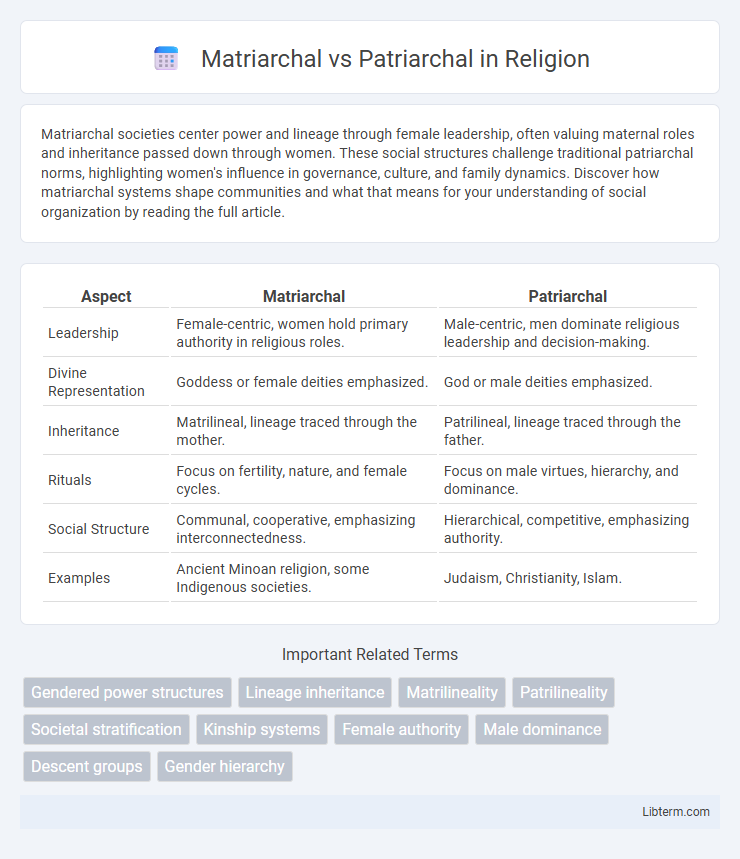Matriarchal societies center power and lineage through female leadership, often valuing maternal roles and inheritance passed down through women. These social structures challenge traditional patriarchal norms, highlighting women's influence in governance, culture, and family dynamics. Discover how matriarchal systems shape communities and what that means for your understanding of social organization by reading the full article.
Table of Comparison
| Aspect | Matriarchal | Patriarchal |
|---|---|---|
| Leadership | Female-centric, women hold primary authority in religious roles. | Male-centric, men dominate religious leadership and decision-making. |
| Divine Representation | Goddess or female deities emphasized. | God or male deities emphasized. |
| Inheritance | Matrilineal, lineage traced through the mother. | Patrilineal, lineage traced through the father. |
| Rituals | Focus on fertility, nature, and female cycles. | Focus on male virtues, hierarchy, and dominance. |
| Social Structure | Communal, cooperative, emphasizing interconnectedness. | Hierarchical, competitive, emphasizing authority. |
| Examples | Ancient Minoan religion, some Indigenous societies. | Judaism, Christianity, Islam. |
Defining Matriarchal and Patriarchal Societies
Matriarchal societies are social systems where women hold primary power in roles of political leadership, moral authority, and control over property, often emphasizing kinship traced through the maternal line. Patriarchal societies, by contrast, are structured around male dominance in authority, inheritance, and leadership, with lineage typically traced through the paternal line. These contrasting frameworks shape cultural norms, governance, and social roles within communities.
Historical Origins and Evolution
Matriarchal societies, characterized by female-centered lineage and leadership, historically emerged in early agricultural and hunter-gatherer communities, emphasizing communal property and maternal kinship systems. Patriarchal systems evolved later with the rise of centralized states and organized warfare, prioritizing male dominance in political, economic, and familial hierarchies. Archaeological evidence from Neolithic settlements and ancient civilizations like Mesopotamia reveals the transition from matrilineal to patrilineal structures, driven by shifts in social organization and resource control.
Key Characteristics of Matriarchy
Matriarchy is characterized by social structures where women hold primary power in roles of political leadership, moral authority, and control over property. Kinship and inheritance often follow the maternal line, emphasizing female lineage and descent. These societies typically value cooperative decision-making and community well-being, contrasting with patriarchal emphasis on male dominance and hierarchical authority.
Key Characteristics of Patriarchy
Patriarchy is characterized by male dominance in social, political, and economic spheres, where power and inheritance typically pass through the male lineage. It often features gender roles that prioritize men as leaders, decision-makers, and primary breadwinners, while women may face systemic limitations on authority and rights. This structure reinforces hierarchical systems that maintain male privilege and control over resources and societal norms.
Social and Family Structures
Matriarchal societies center family lineage and inheritance through the female line, often granting women authority over domestic and social decisions, which fosters communal support and cooperative child-rearing. Patriarchal systems emphasize male dominance in family and social hierarchies, with inheritance and leadership typically passing through male members, shaping gender roles and power dynamics that influence legal and cultural norms. These contrasting structures impact social organization, gender relations, and resource distribution within communities worldwide.
Gender Roles and Responsibilities
Matriarchal societies assign leadership and inheritance roles predominantly to women, emphasizing caregiving, communal decision-making, and resource management within familial structures. Patriarchal systems prioritize male authority in political, economic, and social domains, often linking masculinity to protection, provision, and public leadership responsibilities. Gender roles in matriarchal cultures tend to be more fluid and egalitarian, whereas patriarchal frameworks reinforce rigid distinctions and hierarchical power dynamics between men and women.
Power Dynamics and Decision-Making
Matriarchal societies emphasize power dynamics where women hold primary authority in social, political, and familial decision-making, often guiding resource distribution and community organization. In contrast, patriarchal systems concentrate power predominantly in male hands, with men controlling major decisions related to governance, economy, and social hierarchy. These differing power structures shape gender roles, influence leadership styles, and affect societal norms regarding authority and control.
Cultural and Religious Influences
Matriarchal societies often emphasize female deities and ancestral worship, shaping cultural values around maternal authority and communal decision-making. Patriarchal systems typically center religious doctrines that endorse male leadership, reinforcing gender hierarchies through rituals and sacred texts. These cultural and religious frameworks profoundly influence societal roles, inheritance practices, and power distribution within their respective communities.
Modern-Day Examples and Case Studies
Modern-day matriarchal societies such as the Mosuo in China emphasize female leadership in family and community decision-making, contrasting with patriarchal systems like Saudi Arabia, where male authority dominates political and social structures. Studies on the Khasi tribe in India reveal that property inheritance and clan leadership are matrilineal, promoting women's roles, while patriarchal cultures exhibit lineage and power concentrated through male descendants. Comparative analysis highlights how economic development, gender equality indices, and social policies differ significantly between matriarchal and patriarchal contexts, influencing education, workforce participation, and legal rights.
Impact on Society and Future Trends
Matriarchal societies often emphasize communal decision-making and gender equality, promoting social cohesion and inclusive leadership, while patriarchal systems typically concentrate power among male leaders, influencing hierarchical social structures and gender roles. The impact on society includes variations in property rights, inheritance laws, and educational opportunities that affect economic development and social mobility. Future trends suggest a convergence towards more egalitarian frameworks, driven by global gender equality movements and the increasing recognition of diverse leadership models in governance and community organization.
Matriarchal Infographic

 libterm.com
libterm.com